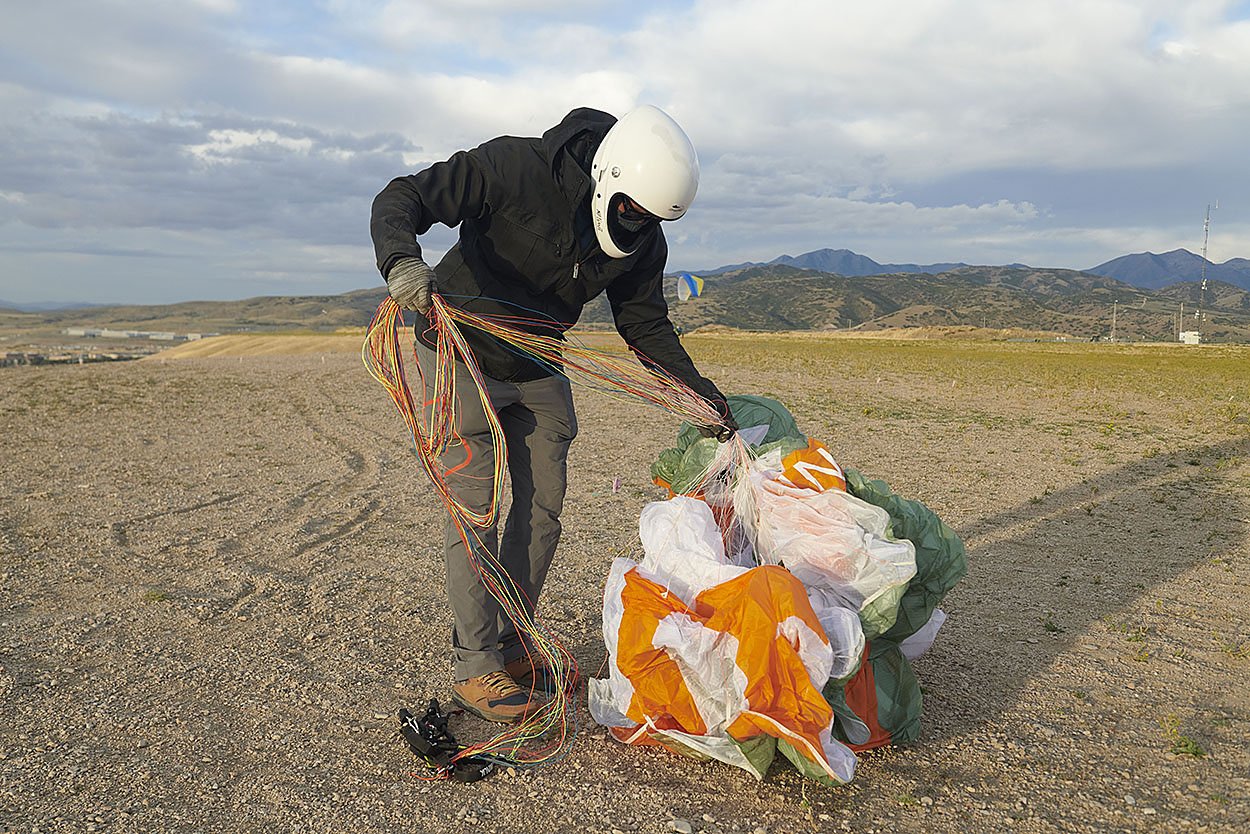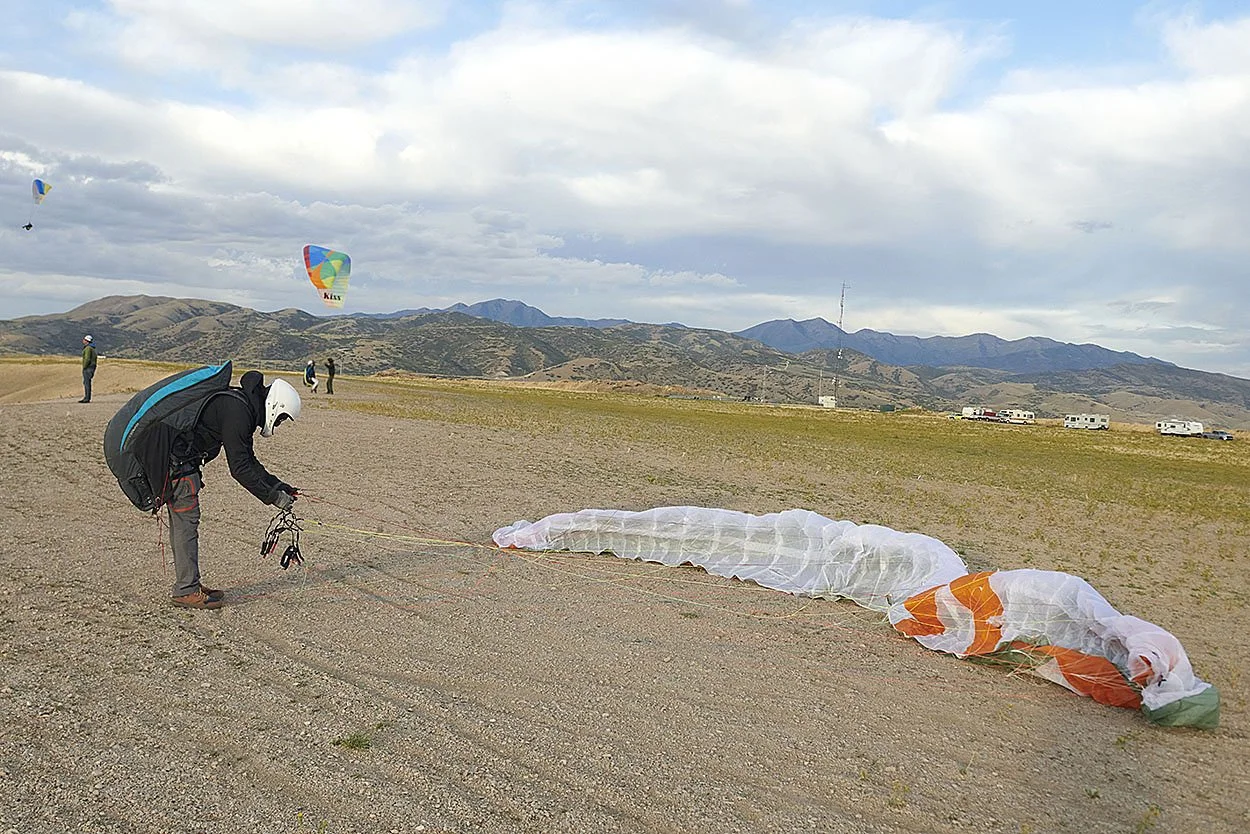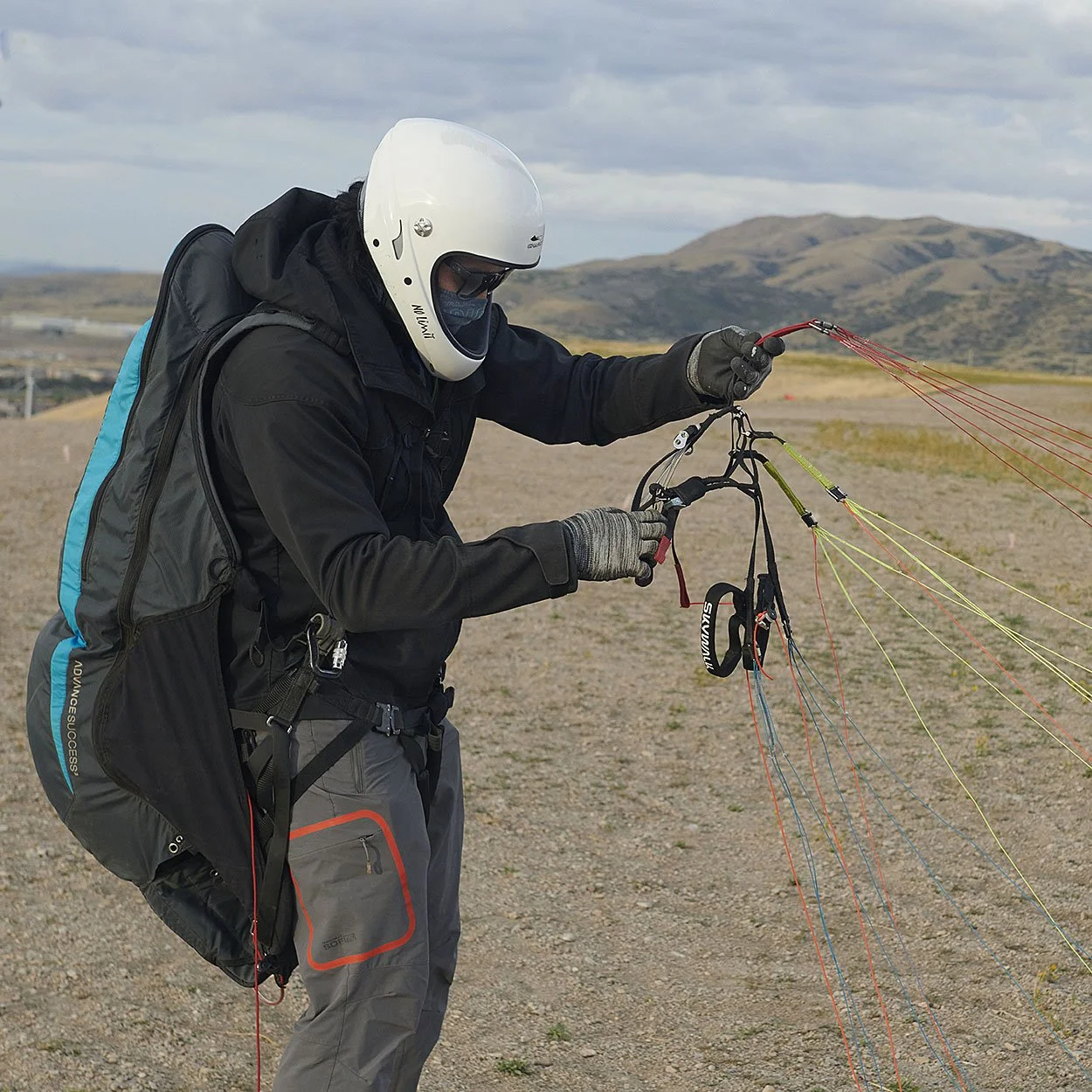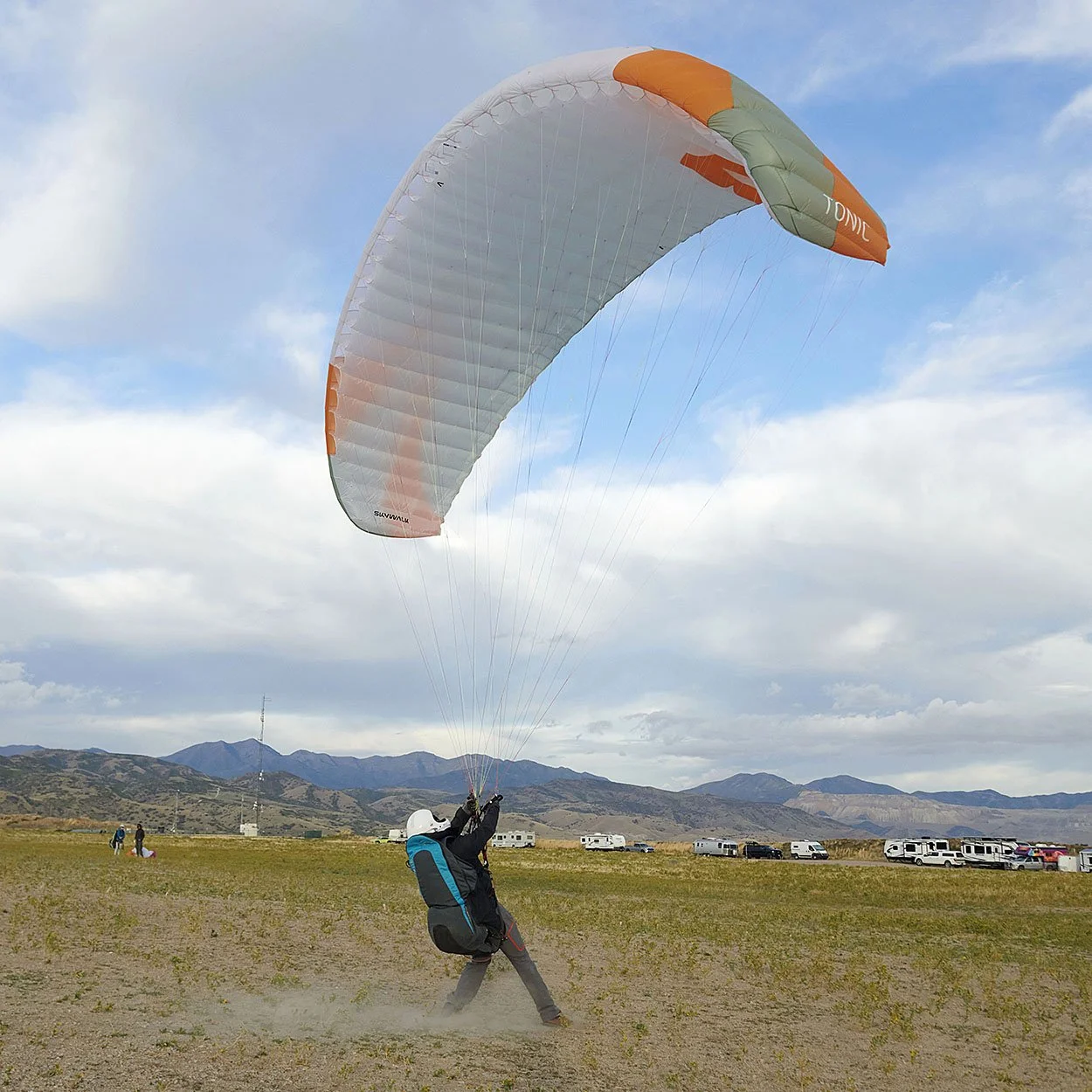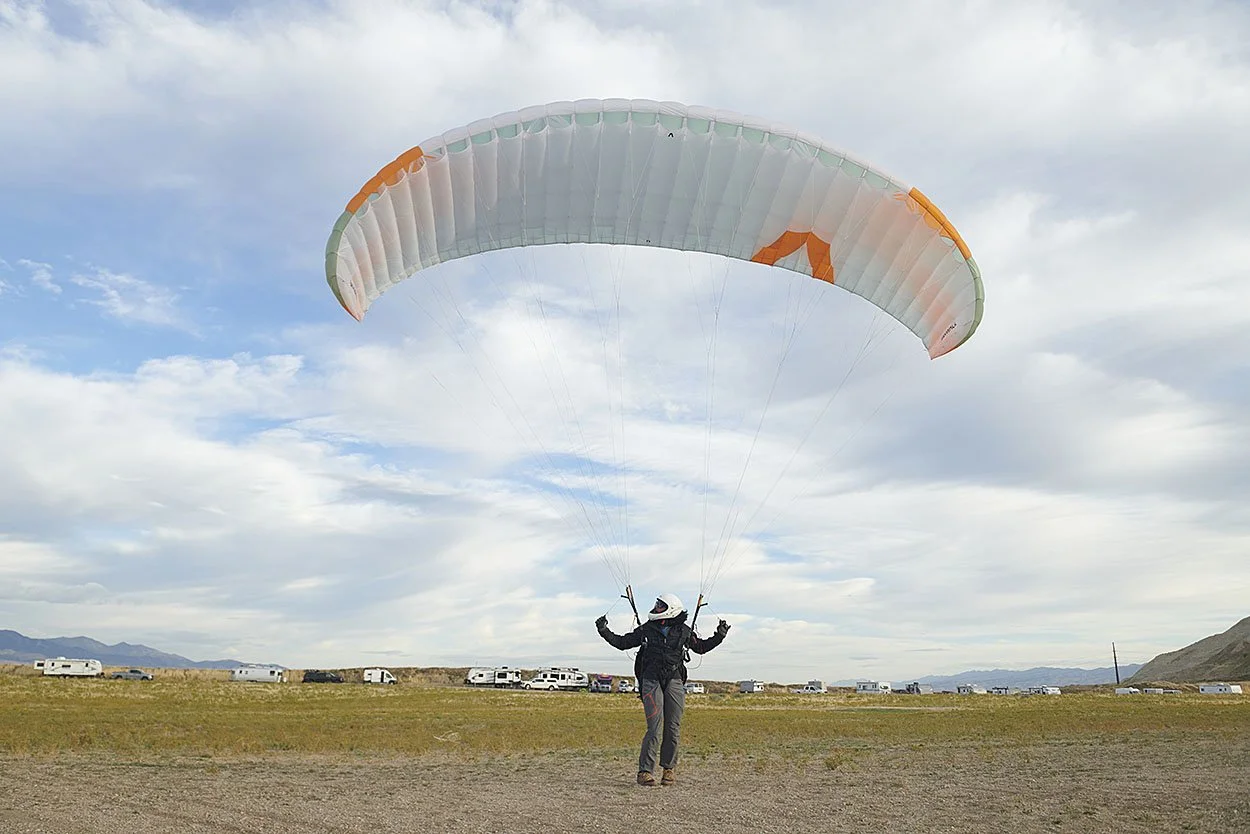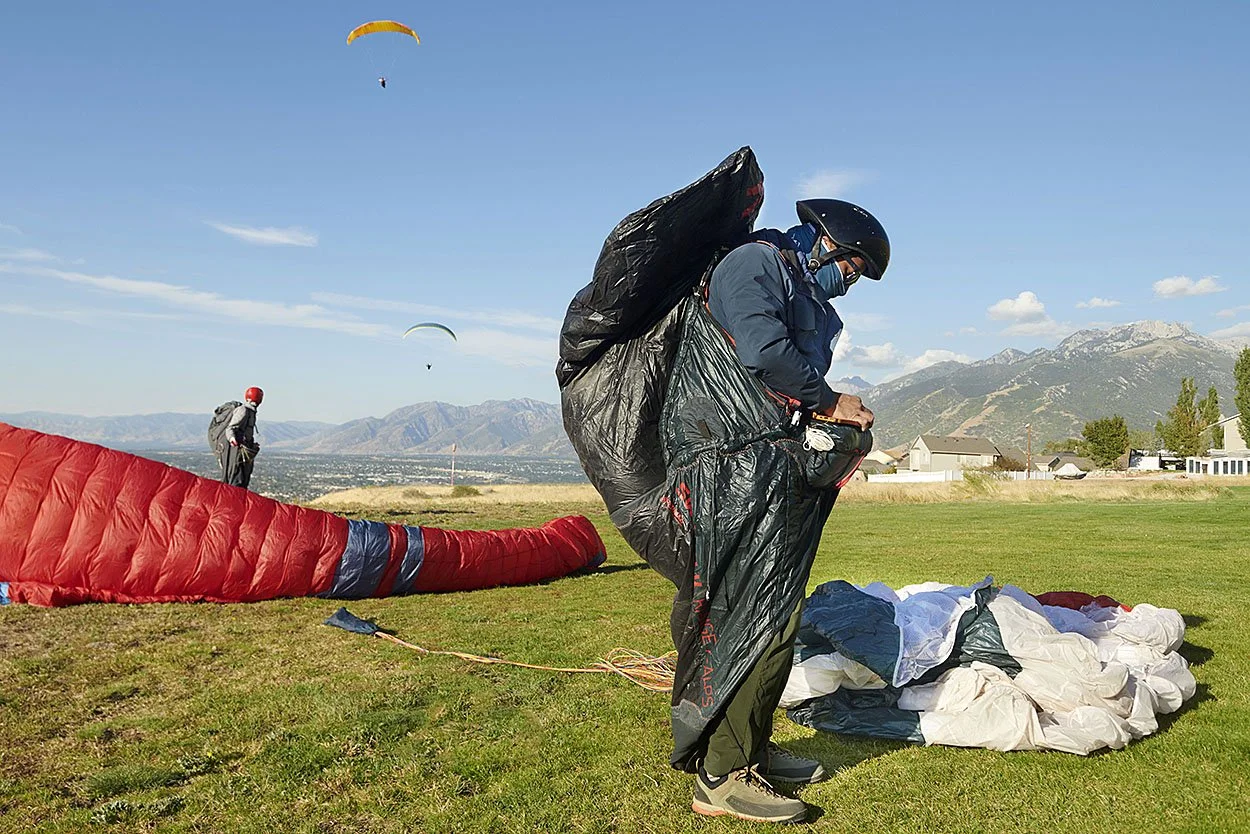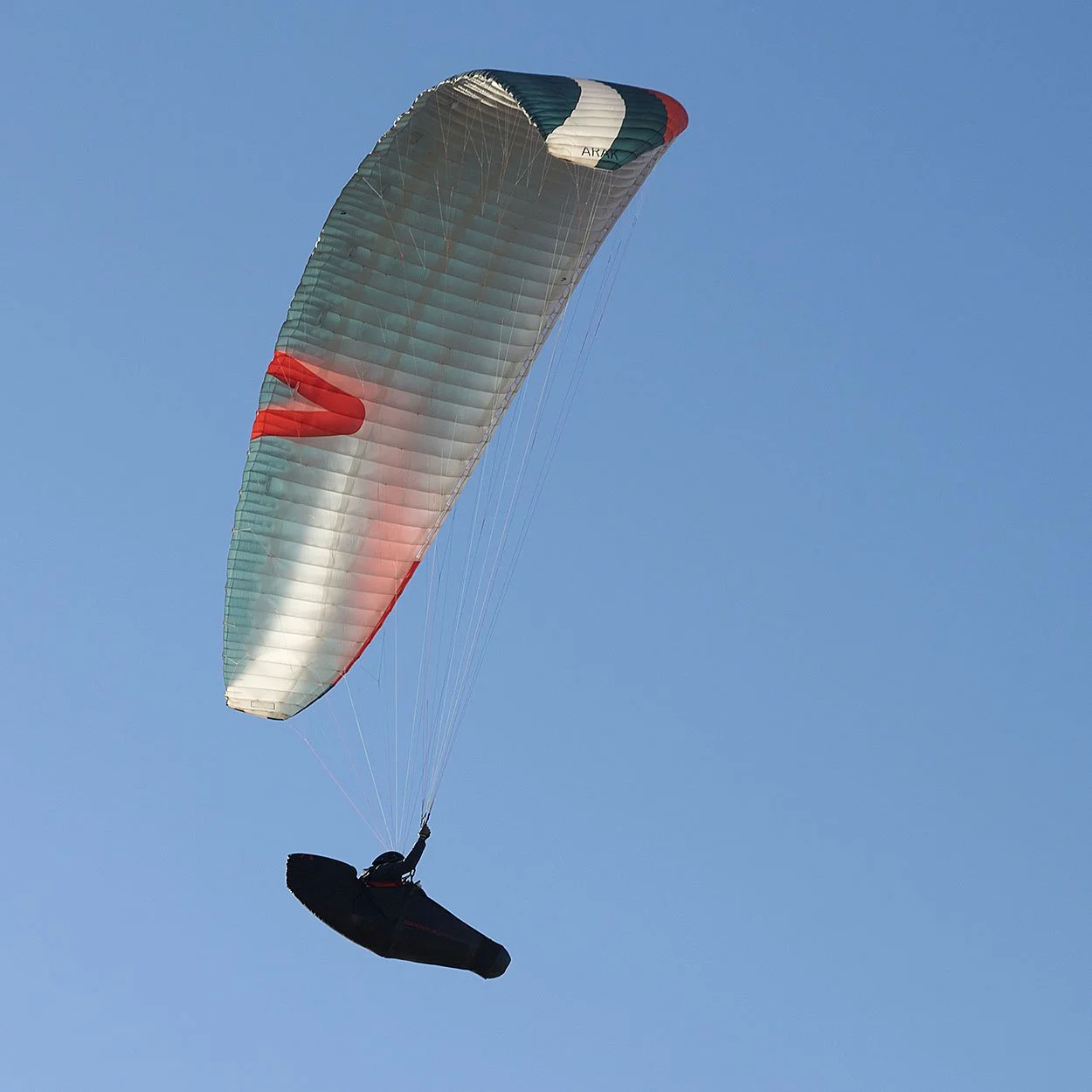the point of the mountain
Pujan carefully frees his lines, tangled in a patch of sticky Gumweed.
This is the story of The Point of the Mountain
I was on the phone with Pujan (POOH-j-uh-n) trying to understand the wind. A storm was building and I thought, “Great, plenty of wind for flight.” “No,” Pujan was saying. “That is not the wind we need; not the right kind of weather. What we need is a clear sky or small clouds. If dawn looks that way I can fly and you should come.” Pujan was heading home - to Nepal - on a paragliding trip and we only had a handful of days.
Two worlds side by side: 10 lanes of relentless traffic on the interstate, and to the east at the edge of the foothills, the Point of the Mountain Flight Park, the epicenter of paragliding in Utah. I have seen paragliders in flight up and down the Wasatch Front; the familiar ellipse riding on an early full moon above the Botanical Gardens, or off of Grandeur Peak, but mostly at The Point.
Paragliders use only wind for propulsion and The Point is considered to be ideal for flying. Talking to Hal Franklin, Pujan’s flight instructor and longtime friend, I sense there is wind instead of blood in his veins. He starts at the beginning, “The sun is the machine that drives everything during the day. The sun doesn’t heat the air. The sun heats the ground, and the ground heats the air.” Yes. He continues, “There is a pressure change in the air mass; the heat expands the mass making the air less dense. At night, the air mass contracts as it cools.”
The Point of the Mountain sits between the higher Utah Valley and the Great Salt Lake Valley, with the Great Salt Lake at its lowest point. When the air mass cools at night, the cold, dense air flows to lower ground. This Katabatic flow creates the southerly winds for optimal dawn flying.
If you look down on the Wasatch Mountains, The Point protrudes significantly from the Range. Hal explains, “Think of the protuberance as the choke point of the hourglass that is the Utah Valley and the Great Salt Lake Valley.” When the air flows through this constricted space, it accelerates. During the warmer seasons, the air above the land near the lake is warmed during the day, expands and is less dense. The air above the lake is cooler and it flows under the warm air. In a rolling motion, the cooler air pushes up the hotter air. This northerly wind flow is strong enough that at the choke point, taking the path of least resistance, as Hal tells the story, “The air rises up the smooth and sculpted sides” of the ancient Lake Bonneville shoreline at the North Flight Park, creating perfect evening flying conditions.
I journey to meet up with and photograph our pilot.
We meet at dawn at the South Flight Park. Pujan unties his stuff sack. This simple act is cinematic and already there is nothing to stage.
The pilot begins his pre-flight inspection, running his hands along the coloured lines, confirming connections and checking for cuts or frays among the lines of his paraglider.
The glider is spread out for further inspection. Pujan checks that the suspension lines and risers are not tangled; that the wing’s leading edge - with its cell openings between the two layers of fabric - is facing into the wind for air inflow and wing inflation. He can then connect the lines to the risers.
The orange brake lines need to be free from twists. Pujan stacks the risers so that when the wing lifts, the red A risers are free and can lift the leading edge of the wing. When the A risers and the brake risers are free, the others usually fall into place.
Pujan explains the braking system to me: “The better you are able to control your glider without using the brakes, the better a pilot you are.” Control of the glider’s movement is mostly done by shifting your body, but the brake lines can also be used for steering.
There are two parts to the brakes: the line and the toggle, the black loop. A pulley between the line and the toggle keeps the brake line accessable. Pujan has me imagine: “The wind is blowing directly on your face. Clothes are drying on a line. But instead of clothes you have a curtain, pegged on the one end and the other flapping in the wind. Now with your hands you grab the flapping end and you pull it down. And what happens?” Super-eager student Kirsten replies: “You make a sail!” “Yes, and when you pull down on the tips of the wing, those are the brakes.”
I researched what I could, typing into the information beast, “anatomy of a paraglider” and discovered the links between the pilot and the wing - lines, risers, carabiners, harness. I asked “Why?’, “No way!?”, and “How come?”, but really needed the paragliding beta from the pilot himself. I shared my photographs with Pujan and sitting at the kitchen table with a cup of tea, asked way too many questions. “So what are those red dangling lines?” “Speed bar lines. They change the angle of attack.” “But how do you do this?” “With my feet.” My mind is exploding. The speed bar lines dangle below the harness and are attached with loops around the pilot’s feet. Pressing the speed bar decreases the angle of attack and the glider flies faster.
“As the wing is raised, it passes through a wind window. The middle of the window is called the power zone. This is where you can get yanked.” Pujan explains why he is being dragged through the dust by the strength of the wind in the wing. He anchors his body, engages his core, finds his balance, pivots, and commands the wing.
Step by step for a hundred feet, doubled over, punching forward into the wind, Pujan guides the paraglider toward the launch site.
Pujan selected his mini-wing Skywalk Tonic paraglider for this dawn flight because of the strong winds. “It’s a sporty day!” Pujan tells me. “And the South Flight Park is too dusty for my pod harness.” The Tonic is considered to be both agile and stable in turbulence. This rugged harness allows the pilot’s legs to be free and is constructed using foam for back protection.
Pujan lands safely and manoeuvres the paraglider into place before bringing down the wing against a backdrop of campers. 12 years ago, Pujan and my brother, Ash, pitched their tent along this same edge of the flight field and rose early each day for flying lessons with Hal Franklin of Utah Paragliding.
A southerly wind fills the wind sock and Pujan explains it is too strong to attempt more flights this morning.
Heading home past the gravel and sand mine after his morning flight. I was secretly hoping Pujan would arrive on his one-wheel as he often does, but his off-road motorbike works better for the South Flight Park because of the dirt roads.
We have arrived at the North Flight Park for Pujan’s evening flight. He has strapped into his Skywalk paragliding pod harness, attached his flight deck and is enabling the variometer, which will monitor his rate of climb and descent. The harness has a pouch that carries a reserve parachute, and an inflatable airbag which provides some back protection. He inflates the core with an inflation bag while still on the ground, and the balance inflates in flight. The pod-style harness is more comfortable than the open-seated harness and more aerodynamic.
The pilot starts by crossing his arms, and with them the risers and brakes, because it is best to see the wing as it comes up. “Then,” he says, “I always turn to the left, and go.” The word “turn” is truly inadequate. The process, which requires strength and control to execute flawlessly, is far more balletic than “turn” can convey. With his arms spread out, holding the brake risers, Pujan begins the trek across the flight field toward his selected launch site.
Pujan’s full-wing Skywalk ARAK rises from the flight field.
Insectoid. It is hard to image the grace that will soon follow.
“I am one with the wing,” says Pujan, stepping into the sky.
Beautiful physics: the paraglider in flight. The website of Adrenaline Parapente, based in France, poses the obvious and excellent question: “How does the Paraglider keep itself in the Sky?” The physics is fascinating but I can retain it only for the duration of reading the paragraph before my mind wanders back to the time I threw a stool across the physics lab in high school. I will say simply that the air accelerates more quickly over the top of the self-inflating wing than the bottom, because of the curved shape, creating a vacuum above the wing which generates lift. Of course, there is a force that resists the lift, called drag, which gives the pilot some control. There are thermal and dynamic updrafts for soaring. Hal talked about thermals: “Thermals originate on the ground. As the air is heated, the hotter, less dense air rises straight up. Thermals can be bent by the wind, depending on its speed.”
Pilots navigate a 3D maze of lifts and sinks in the air currents and map out the terrain as they fly in and out of the thermals. Flying in a sink, the pilots lose altitude, while keeping a landing spot in sight. I have so many questions: “Pujan, how do you escape the pod?” “I bend my knees.” “Pujan, how do you land?” “I land like a bird.”
Pujan brings down the wing and carries the 20 kg system back to the flight field, ready for a final flight before the sun dips behind the Oquirrh Mountains.
I am my own fact checker, and have several acknowledgements to make:
1. The paragliding lexicon is not narrow. Is the Skywalk harness a pod? A cocoon? A speed bag? A leg fairing? Does one say wing, sail or canopy? As this is the story of the pilot, Pujan Shrestha, I used the terminology he favours.
2. The wind confounded me. I have done my best to explain the conditions that help make The Point of the Mountain ideal for flight. Special thanks to the legendary paraglider pilot and instructor, Hal Franklin of Utah Paragliding who talked me through Anemology 101.
3. The physics also confounded me.
4. Thank you to the outstanding Pujan Shrestha who fully committed to this project, having nothing to go on but shared excitement.
5. Not a proper bibliography but I give props to these resources I stumbled across: annecy-parapente.fr, whitecloudconcierge.com, thehangglidingfiles.com, outdoorjournal.com, skynomad.com, paragliding-lessons.com, dropzone.com, howstuffworks.com
Bonus image - Pujan Shrestha and Hal Franklin, North Flight Park, The Point of the Mountain, Utah



